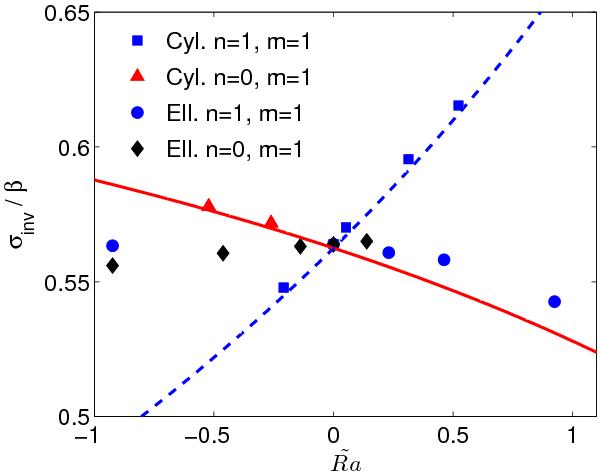Fig. D.1

Growth rate of the TDEI for a cylindrical shell of aspect ratio H/R = 2 with an elliptical cross section (η = 0.2, E = 0.0036, β = 0.47, Pr = 1) and an ellipsoidal shell (η = 0.3, E = 0.0029, β = 0.317, Pr = 1) with a rotation axis of length c = (a + b)/2. The figure compares the numerical growth rate in the autogravitating case where the gravity is given by the Poisson equation for the gravitational potential of a homogeneous fluid (see Cébron et al. 2010c, for details), and the case where the gravity is played by a centrifugal force (n = 0), as in the experiments of Lavorel & Le Bars (2010). The numerical growth rate is translated vertically in the figure, to match the inviscid growth rate 9/16 at  , which corresponds to a surfacic damping term coefficient α = 3.24 for the cylindrical shell (squares and triangles) and α = 3.1 for the ellipsoidal shell (circles and diamonds). Theoretical growth rates are shown by a continuous red line for n = 0, m = 1 and a dashed blue line for n = m = 1.
, which corresponds to a surfacic damping term coefficient α = 3.24 for the cylindrical shell (squares and triangles) and α = 3.1 for the ellipsoidal shell (circles and diamonds). Theoretical growth rates are shown by a continuous red line for n = 0, m = 1 and a dashed blue line for n = m = 1.
Current usage metrics show cumulative count of Article Views (full-text article views including HTML views, PDF and ePub downloads, according to the available data) and Abstracts Views on Vision4Press platform.
Data correspond to usage on the plateform after 2015. The current usage metrics is available 48-96 hours after online publication and is updated daily on week days.
Initial download of the metrics may take a while.


